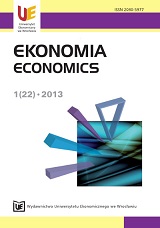Poziom obciążenia fiskalnego jako determinanta nakładów inwestycyjnych w produkcji artykułów spożywczych i napojów
Determinants of investment outlays in manufacture of food products and beverages
Author(s): Dominika Zenka-PodlaszewskaSubject(s): Economy
Published by: Wydawnictwo Uniwersytetu Ekonomicznego we Wrocławiu
Keywords: investments; financial burdens; investment theory; production of food products and beverages
Summary/Abstract: This article aims to present and asses the relationships between the level of investment and financial burdens. Investment expenditures are analyzed as is the financial burden in the greatest food product and beverage manufacturing department in Poland. A three-step analysis method has been employed in this article. Firstly, we analyzed the theoretical relationship between investments and financial burdens in the theories of Keynes, Jorgenson, new classical macroeconomics as well as the real economic cycle. Secondly, we reviewed the Polish and foreign empirical studies available to-date. Thirdly, we carried out an econometric (co-integration) analysis. We analyzed the existence of long-run relationships between the level of investment expenditure and the financial burden using co-integration analysis. Previous co-integration studies looking at the level of integration between series used the ADF and KPSS tests. The co-integration analysis was carried out using the Johansen method. All data used in the article were cleaned using the Census II X-11 method using the Henderson curve. We have assumed that the tax burden is represented by the burden placed on profit before tax (GUS definition). Investments are measured through gross expenditure on fixed assets at constant prices, where the data sources were the GUS Statistical Bulletins from 1995-2009. According to Keynes, excessive income tax leads to a fall in the level of investment. The activities which Keynes believed should increase the level of consumption, include highly progressive income taxes in conjunction with financial support for the poorest. In neoclassical theory, taxes play an important role in setting the cost of capital through the level of investment. For this reason the state should exercise caution when managing fiscal policy, knowing its impact on the level of investment. In Jorgen’s theory, the level of taxation has a negative impact on investment through the cost of capital utilization (in other words together with the interest rate). The models presented as part of new classical macroeconomics have demonstrated that systematic monetary policy cannot have any permanent impact on the level of production as well as the level of investment. The real economic cycle theory shows the relationship between exogenous fiscal policy and investments. Supply side shocks play the main role in the real economic cycle theory. Changes in the institutional environment mean that fiscal policy can be viewed as being a supply-side shock. During our analysis of research carried out to-date, we came to the conclusion that, among others, the average tax rate (measured as an average of the ratio of public sector finance income to GDP and being simultaneously a measure of the share the public sector has in the economy), suggestsa negative correlation with investments.
Journal: Ekonomia
- Issue Year: 2013
- Issue No: 22
- Page Range: 29-49
- Page Count: 21
- Language: Polish

